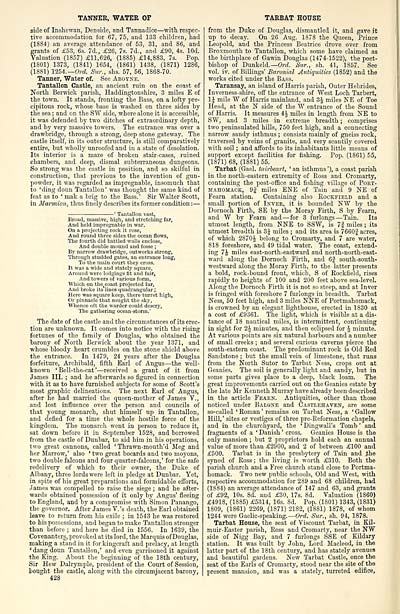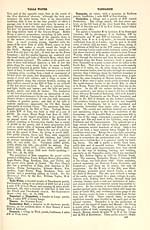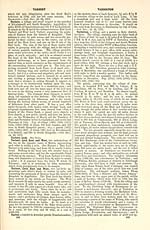Ordnance gazetteer of Scotland > Volume 6
(250) Page 428
Download files
Complete book:
Individual page:
Thumbnail gallery: Grid view | List view

TANNER, WATER OF
side of Inshewan, Denside, and Tannadice — with respec-
tive accommodation for 67, 75, and 133 children, had
(1884) an average attendance of 53, 31, and 86, and
grants of £53, 6s. 7d., £26, 7s. 7d., and £90, 4s. lOd.
Valuation (1857) £11,626, (1885) £14,883, 7s. Pop.
(1801) 1373, (1841) 1654, (1861) 1438, (1871) 1286,
(1881) 125L— Ord. Sur., shs. 57, 56, 1868-70.
Tanner, Water of. See Aboyne.
Tantallon Castle, an ancient ruin on the coast of
North Berwick parish, Haddingtonshire, 3 miles E of
the town. It stands, fronting the Bass, on a lofty pre-
cipitous rock, whose base is washed on three sides by
the sea ; and on the SW side, where alone it is accessible,
it was defended by two ditches of extraordinary depth,
and by very massive towers. The entrance was over a
drawbridge, through a strong, deep stone gateway. The
castle itself, in its outer structure, is still comparatively
entire, but wholly unroofed and in a state of desolation.
Its interior is a maze of broken stair-cases, ruined
chambers, and deep, dismal subterraneous dungeons.
So strong was the castle in position, and so skilful in
construction, that previous to the invention of gun-
powder, it was regarded as impregnable, insomuch that
to 'ding doun Tantallon' was thought the same kind of
feat as to ' mak a brig to the Bass. ' Sir Walter Scott,
in Marmion, thus finely describes its former condition : —
' Tautallou vast,
Broad, massive, high, and stretching far,
And held impregnable in war.
On a projecting rock it rose,
And round three sides the ocean flows.
The fourth did battled walls enclose,
And double mound and fosse ;
By narrow drawbridge, outworks strong,
Through studded gates, an entrance long,
To the main court they cross.
It was a wide and stately square,
Around were lodgings fit and fair,
And towers of various form,
Which on the ( coast projected far,
And broke its lines quadrangular ;
Here was square keep, there turret high,
Or pinnacle that sought the sky,
Whence oft the warder could descry,
The gathering ocean-storm.'
The date of the castle and the circumstances of its erec-
tion are unknown. It comes into notice with the rising
fortunes of the family of Douglas, who obtained the
barony of North Berwick about the year 1371, and
whose bloody heart crumbles on the stone shield above
the entrance. In 1479, 24 years after the Douglas
forfeiture, Archibald, fifth Earl of Angus — the well-
known ' Bell-the-cat ' — received a grant of it from
James III. ; and he afterwards so figured in connection
with it as to have furnished subjects for some of Scott's
most graphic delineations. The next Earl of Angus,
after he had married the queen-mother of James V.,
and lost influence over the person and councils of
that young monarch, shut himself up in Tantallon,
and defied for a time the whole hostile force of the
kingdom. The monarch went in person to reduce it,
sat down before it in September 1528, and borrowed
from the castle of Dunbar, to aid him in his operations,
two great cannons, called ' Thrawn-mouth'd Meg and
her Marrow,' also ' two great bocards and two moyons,
two double falcons and four quarter-falcons, ' for the safe
redelivery of which to their owner, the Duke of
Albany, three lords were left in pledge at Dunbar. Yet,
in spite of his great preparations and formidable efforts,
James was compelled to raise the siege ; and he after-
wards obtained possession of it only by Angus' fleeing
to England, and by a compromise with Simon Panango,
the governor. After James V. 's death, the Earl obtained
leave to return from his exile ; in 1543 he was restored
to his possessions, and began to make Tantallon stronger
than before ; and here he died in 1556. In 1639, the
Covenanters, provoked at its lord, the Marquis of Douglas,
making a stand in it for kingcraft and prelacy, at length
'dang doun Tantallon,' and even garrisoned it against
the King. About the beginning of the 18th century,
Sir Hew Dalrymple, president of the Court of Session,
bought the castle, along with the circumjacent barony,
428
TARBAT HOUSE
from the Duke of Douglas, dismantled it, and gave it
up to decay. On 26 Aug. 1878 the Queen, Prince
Leopold, and the Princess Beatrice drove over from
Broxmouth to Tantallon, which some have claimed as
the birthplace of Gawin Douglas (1474-1522), the poet-
bishop of Dunkeld.— Ord. Sur., sh. 41, 1857. See
vol. iv. of Billings' Baronial Antiquities (1852) and the
works cited under the Bass.
Taransay, an island of Harris parish, Outer Hebrides,
Inverness-shire, off the entrance of West Loch Tarbert,
1 J mile W of Harris mainland, and 3J miles NE of Toe
Head, at the N side of the W entrance of the Sound
of Harris. It measures 4J miles in length from NE to
SW, and 3 miles in extreme breadth ; comprises
two peninsulated hills, 750 feet high, and a connecting
narrow sandy isthmus ; consists mainly of gneiss rock,
traversed by veins of granite, and very scantily covered
with soil ; and affords to its inhabitants little means of
support except facilities for fishing. Pop. (1861) 55,
(1871)68,(1881)55.
Tarbat (Gael, tairbeart, ' an isthmus '), a coast parish
in the north-eastern extremity of Ross and Cromarty,
containing the post-office and fishing village of Port-
mahomack, 9| miles ENE of Tain and 9 NE of
Fearn station. Containing also Rockfield and a
small portion of Inver, it is bounded NW by the
Dornoch Firth, SE by the Moray Firth, S by Fearn,
and W by Fearn and — for 3 furlongs — Tain. Its
utmost length, from NNE to SSW, is 7| miles ; its
utmost breadth is 3J miles ; and its area is 7660f acres,
of which 2870J belong to Cromarty, and 7 are water,
818 foreshore, and 49 tidal water. The coast, extend-
ing 7J miles east-north-eastward and north-north-east-
ward along the Dornoch Firth, and 6J south-south-
westward along the Moray Firth, to the latter presents
a bold, rock-bound front, which, S of Rockfield, rises
rapidly to heights of 100 and 200 feet above sea-level.
Along the Dornoch Firth it is not so steep, and at Inver
is fringed with foreshore 7 furlongs in breadth. Tarbat
Ness, 50 feet high, and 3 miles NNE of Portmahomack,
is crowned by an elegant lighthouse, erected in 1830 at
a cost of £9361. The light, which is visible at a dis-
tance of 18 nautical miles, is intermittent, continuing
in sight for 2J minutes, and then eclipsed for J minute.
At various points are six natural harbours and a number
of small creeks ; and several curious caverns pierce the
south-eastern coast. The predominant rock is Old Red
Sandstone ; but the small vein of limestone, that runs
from the North Sutor to Tarbat Ness, crops out at
Geanies. The soil is generally light and sandy, but in
some parts gives place to a deep, black loam. The
great improvements carried out on the Geanies estate by
the late Mr Kenneth Murray have already been described
in the article Fearn. Antiquities, other than those
noticed under Balone and Castlehaven, are some
so-called ' Roman ' remains on Tarbat Ness, a ' Gallow
Hill, ' sites or vestiges of three pre-Reformation chapels,
and in the churchyard, the ' Dingwall's Tomb ' and
fragments of a ' Danish ' cross. Geanies House is the
only mansion ; but 2 proprietors hold each an annual
value of more than £2900, and 2 of between £100 and
£500. Tarbat is in the presbytery of Tain and .the
synod of Ross ; the living is worth £310. Both the
parish church and a Free church stand close to Portma-
homack. Two new public schools, Old and West, with
respective accommodation for 289 and 68 children, had
(1884) an average attendance of 147 and 63, and grants
of £92, 10s. 8d. and £30, 17s. 8d. Valuation (1860)
£4918, (1885) £5314, 16s. 8d. Pop. (1801) 1343, (1831)
1809, (1861) 2269, (1871) 2182, (1881) 1878, of whom
1244 were Gaelic-speaking. — Ord. Sur., sh. 94, 1878.
Tarbat House, the seat of Viscount Tarbat, in Kil-
muir-Easter parish, Ross and Cromarty, near the NW
side of Nigg Bay, and 7 furlongs SSE of Kildary
station. It was built by John, Lord Macleod, in the
latter part of the 18th century, and has stately avenues
and beautiful gardens. New Tarbat Castle, once the
seat of the Earls of Cromarty, stood near the site of the
present mansion, and was a stately, turreted edifice,
side of Inshewan, Denside, and Tannadice — with respec-
tive accommodation for 67, 75, and 133 children, had
(1884) an average attendance of 53, 31, and 86, and
grants of £53, 6s. 7d., £26, 7s. 7d., and £90, 4s. lOd.
Valuation (1857) £11,626, (1885) £14,883, 7s. Pop.
(1801) 1373, (1841) 1654, (1861) 1438, (1871) 1286,
(1881) 125L— Ord. Sur., shs. 57, 56, 1868-70.
Tanner, Water of. See Aboyne.
Tantallon Castle, an ancient ruin on the coast of
North Berwick parish, Haddingtonshire, 3 miles E of
the town. It stands, fronting the Bass, on a lofty pre-
cipitous rock, whose base is washed on three sides by
the sea ; and on the SW side, where alone it is accessible,
it was defended by two ditches of extraordinary depth,
and by very massive towers. The entrance was over a
drawbridge, through a strong, deep stone gateway. The
castle itself, in its outer structure, is still comparatively
entire, but wholly unroofed and in a state of desolation.
Its interior is a maze of broken stair-cases, ruined
chambers, and deep, dismal subterraneous dungeons.
So strong was the castle in position, and so skilful in
construction, that previous to the invention of gun-
powder, it was regarded as impregnable, insomuch that
to 'ding doun Tantallon' was thought the same kind of
feat as to ' mak a brig to the Bass. ' Sir Walter Scott,
in Marmion, thus finely describes its former condition : —
' Tautallou vast,
Broad, massive, high, and stretching far,
And held impregnable in war.
On a projecting rock it rose,
And round three sides the ocean flows.
The fourth did battled walls enclose,
And double mound and fosse ;
By narrow drawbridge, outworks strong,
Through studded gates, an entrance long,
To the main court they cross.
It was a wide and stately square,
Around were lodgings fit and fair,
And towers of various form,
Which on the ( coast projected far,
And broke its lines quadrangular ;
Here was square keep, there turret high,
Or pinnacle that sought the sky,
Whence oft the warder could descry,
The gathering ocean-storm.'
The date of the castle and the circumstances of its erec-
tion are unknown. It comes into notice with the rising
fortunes of the family of Douglas, who obtained the
barony of North Berwick about the year 1371, and
whose bloody heart crumbles on the stone shield above
the entrance. In 1479, 24 years after the Douglas
forfeiture, Archibald, fifth Earl of Angus — the well-
known ' Bell-the-cat ' — received a grant of it from
James III. ; and he afterwards so figured in connection
with it as to have furnished subjects for some of Scott's
most graphic delineations. The next Earl of Angus,
after he had married the queen-mother of James V.,
and lost influence over the person and councils of
that young monarch, shut himself up in Tantallon,
and defied for a time the whole hostile force of the
kingdom. The monarch went in person to reduce it,
sat down before it in September 1528, and borrowed
from the castle of Dunbar, to aid him in his operations,
two great cannons, called ' Thrawn-mouth'd Meg and
her Marrow,' also ' two great bocards and two moyons,
two double falcons and four quarter-falcons, ' for the safe
redelivery of which to their owner, the Duke of
Albany, three lords were left in pledge at Dunbar. Yet,
in spite of his great preparations and formidable efforts,
James was compelled to raise the siege ; and he after-
wards obtained possession of it only by Angus' fleeing
to England, and by a compromise with Simon Panango,
the governor. After James V. 's death, the Earl obtained
leave to return from his exile ; in 1543 he was restored
to his possessions, and began to make Tantallon stronger
than before ; and here he died in 1556. In 1639, the
Covenanters, provoked at its lord, the Marquis of Douglas,
making a stand in it for kingcraft and prelacy, at length
'dang doun Tantallon,' and even garrisoned it against
the King. About the beginning of the 18th century,
Sir Hew Dalrymple, president of the Court of Session,
bought the castle, along with the circumjacent barony,
428
TARBAT HOUSE
from the Duke of Douglas, dismantled it, and gave it
up to decay. On 26 Aug. 1878 the Queen, Prince
Leopold, and the Princess Beatrice drove over from
Broxmouth to Tantallon, which some have claimed as
the birthplace of Gawin Douglas (1474-1522), the poet-
bishop of Dunkeld.— Ord. Sur., sh. 41, 1857. See
vol. iv. of Billings' Baronial Antiquities (1852) and the
works cited under the Bass.
Taransay, an island of Harris parish, Outer Hebrides,
Inverness-shire, off the entrance of West Loch Tarbert,
1 J mile W of Harris mainland, and 3J miles NE of Toe
Head, at the N side of the W entrance of the Sound
of Harris. It measures 4J miles in length from NE to
SW, and 3 miles in extreme breadth ; comprises
two peninsulated hills, 750 feet high, and a connecting
narrow sandy isthmus ; consists mainly of gneiss rock,
traversed by veins of granite, and very scantily covered
with soil ; and affords to its inhabitants little means of
support except facilities for fishing. Pop. (1861) 55,
(1871)68,(1881)55.
Tarbat (Gael, tairbeart, ' an isthmus '), a coast parish
in the north-eastern extremity of Ross and Cromarty,
containing the post-office and fishing village of Port-
mahomack, 9| miles ENE of Tain and 9 NE of
Fearn station. Containing also Rockfield and a
small portion of Inver, it is bounded NW by the
Dornoch Firth, SE by the Moray Firth, S by Fearn,
and W by Fearn and — for 3 furlongs — Tain. Its
utmost length, from NNE to SSW, is 7| miles ; its
utmost breadth is 3J miles ; and its area is 7660f acres,
of which 2870J belong to Cromarty, and 7 are water,
818 foreshore, and 49 tidal water. The coast, extend-
ing 7J miles east-north-eastward and north-north-east-
ward along the Dornoch Firth, and 6J south-south-
westward along the Moray Firth, to the latter presents
a bold, rock-bound front, which, S of Rockfield, rises
rapidly to heights of 100 and 200 feet above sea-level.
Along the Dornoch Firth it is not so steep, and at Inver
is fringed with foreshore 7 furlongs in breadth. Tarbat
Ness, 50 feet high, and 3 miles NNE of Portmahomack,
is crowned by an elegant lighthouse, erected in 1830 at
a cost of £9361. The light, which is visible at a dis-
tance of 18 nautical miles, is intermittent, continuing
in sight for 2J minutes, and then eclipsed for J minute.
At various points are six natural harbours and a number
of small creeks ; and several curious caverns pierce the
south-eastern coast. The predominant rock is Old Red
Sandstone ; but the small vein of limestone, that runs
from the North Sutor to Tarbat Ness, crops out at
Geanies. The soil is generally light and sandy, but in
some parts gives place to a deep, black loam. The
great improvements carried out on the Geanies estate by
the late Mr Kenneth Murray have already been described
in the article Fearn. Antiquities, other than those
noticed under Balone and Castlehaven, are some
so-called ' Roman ' remains on Tarbat Ness, a ' Gallow
Hill, ' sites or vestiges of three pre-Reformation chapels,
and in the churchyard, the ' Dingwall's Tomb ' and
fragments of a ' Danish ' cross. Geanies House is the
only mansion ; but 2 proprietors hold each an annual
value of more than £2900, and 2 of between £100 and
£500. Tarbat is in the presbytery of Tain and .the
synod of Ross ; the living is worth £310. Both the
parish church and a Free church stand close to Portma-
homack. Two new public schools, Old and West, with
respective accommodation for 289 and 68 children, had
(1884) an average attendance of 147 and 63, and grants
of £92, 10s. 8d. and £30, 17s. 8d. Valuation (1860)
£4918, (1885) £5314, 16s. 8d. Pop. (1801) 1343, (1831)
1809, (1861) 2269, (1871) 2182, (1881) 1878, of whom
1244 were Gaelic-speaking. — Ord. Sur., sh. 94, 1878.
Tarbat House, the seat of Viscount Tarbat, in Kil-
muir-Easter parish, Ross and Cromarty, near the NW
side of Nigg Bay, and 7 furlongs SSE of Kildary
station. It was built by John, Lord Macleod, in the
latter part of the 18th century, and has stately avenues
and beautiful gardens. New Tarbat Castle, once the
seat of the Earls of Cromarty, stood near the site of the
present mansion, and was a stately, turreted edifice,
Set display mode to: Large image | Transcription
Images and transcriptions on this page, including medium image downloads, may be used under the Creative Commons Attribution 4.0 International Licence unless otherwise stated. ![]()
| Gazetteers of Scotland, 1803-1901 > Ordnance gazetteer of Scotland > Volume 6 > (250) Page 428 |
|---|
| Permanent URL | https://digital.nls.uk/97390602 |
|---|
| Attribution and copyright: |
|
|---|---|

